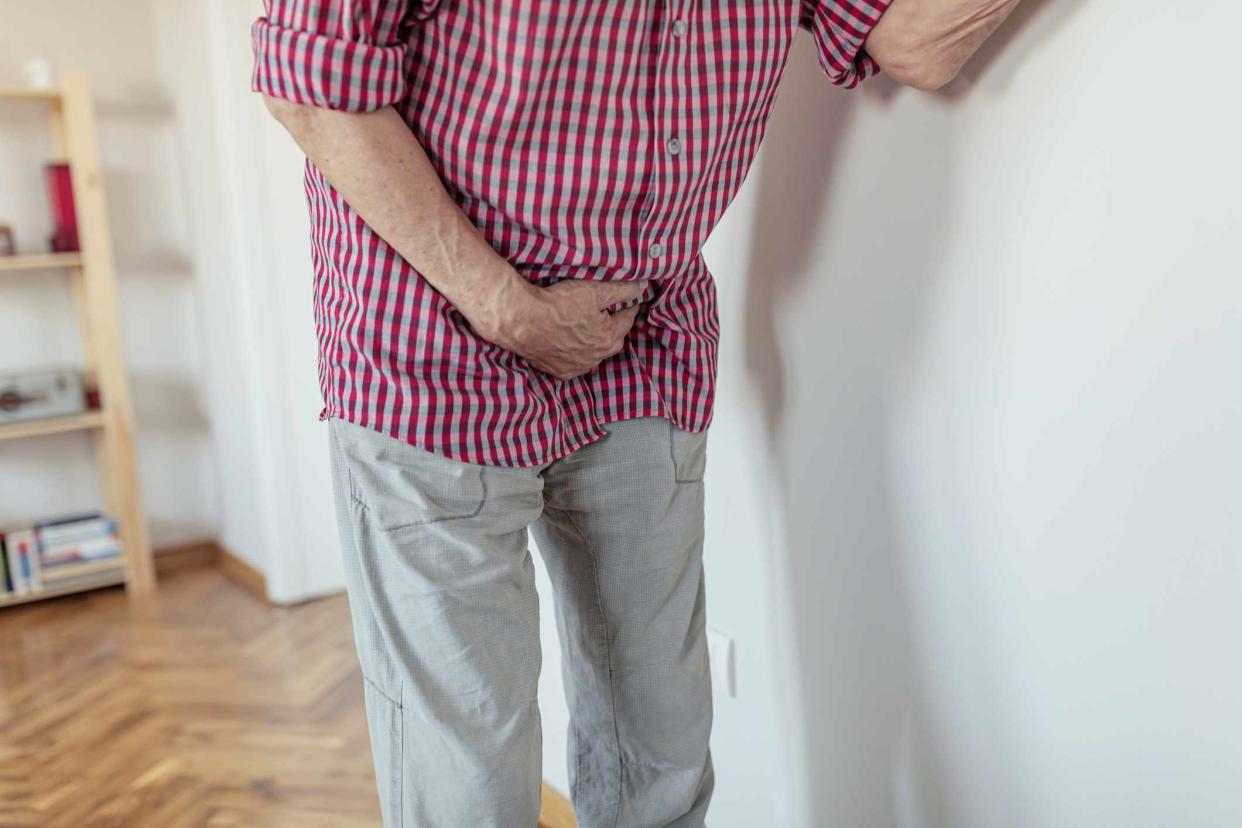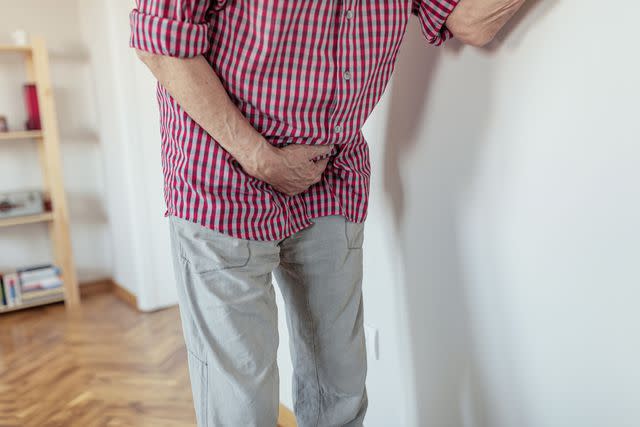Bladder Spasms

Medically reviewed by Matthew Wosnitzer, MD
A bladder spasm, also known as detrusor hyperreflexia, is when the bladder muscle squeezes involuntarily without warning. In addition to pain or discomfort, the spasms can lead to bladder leakage or the sudden, uncontrollable urge to urinate (pee).
There are many causes of bladder spasms, some more serious than others. These include medications, urinary tract infections, interstitial cystitis, and bladder cancer. Though the treatment can vary by the underlying cause, drugs and pelvic exercises can help reduce spasms and bladder leakage.
This article describes the symptoms and causes of bladder spasms, including what is involved in diagnosing and treating this common urological symptom. It also explains when it is time to see your healthcare provider or ask for a referral to a specialist known as a urologist.

Symptoms of Bladder Spasms
The bladder is a hollow muscular organ that serves as the reservoir for urine. When it fills with urine, the internal pressure sends signals to the brain that it is time to pee.
While you can control urination to some degree with voluntary muscles in the urethra (the tube through which urine exits the body), the main muscle in the wall of the bladder—called the detrusor muscle—is involuntary (done without conscious control). When it is time to urinate, the detrusor muscle will contract on its own to fully empty the bladder.
Bladder spasms occur when the detrusor muscle contracts spontaneously and often when the bladder is not significantly filled. When this happens, it can cause:
Convulsive cramping in the lower abdomen, ranging from mild to severe
Pressure and/or burning in the urethra
Urge incontinence (the strong, sudden need to urinate that causes leakage)
Bladder spasms can affect people of any sex, both adults and children.
Bladder spasms are a symptom of overactive bladder (OAB). Also known as polyuria, OAB is diagnosed when you experience two or more of the following symptoms:
Urinating eight or more times a day or two or more times at night
Urinary urgency (the sudden, strong need to pee)
Urge incontinence
Causes of Bladder Spasms
Bladder spasms can occur when something irritates the bladder or there is a malfunctioning of the nerves in the lower spine that regulate bladder function (the sacral nerves). Some cases may also be idiopathic, meaning they occur for no known reason.
Common causes of bladder spasms include:
Urinary tract infections (UTIs): Usually caused by bacteria, these infections can migrate from the urethra to the bladder, causing cystitis (bladder inflammation).
Interstitial cystitis (IC): Also known as painful bladder syndrome, IC is an idiopathic condition caused neither by infection nor a disease.
Urinary catheters: These flexible tubes, used to drain urine from the bladder, commonly cause bladder spasms. Ureteral stents (tubes to help drain the kidney and ureter) can also cause bladder spasms.
Neurological disorders: Cerebral palsy, multiple sclerosis, Parkinson's disease, and stroke are common causes of neurogenic bladder (the nerve-related loss of bladder control).
Pelvic surgery: Extensive surgery in the pelvis (including bladder surgery, hysterectomy, and prostatectomy) can damage sacral nerves or the nearby nerves that supply them.
Diabetic neuropathy: The progressive nerve damage caused by uncontrolled diabetes can lead to detrusor muscle dysfunction.
Spinal cord injury: Detrusor spasms are common when there is a lesion or injury to the lower part of the spine, called a suprasacral spinal cord lesion.
Multiple vaginal births: The pressure placed on the sacral spine during multiple vaginal deliveries can also lead to detrusor dysfunction and bladder spasms.
Bladder cancer: In addition to symptoms like blood in the urine, bladder cancer can cause spasms when the tumor invades the muscular wall of the bladder.
Related:What Causes Frequent Urination?
What Medications Can Cause Bladder Spasms?
Numerous medications can cause bladder spasms. Many irritate the bladder when they are broken down in the kidneys and passed to the bladder in urine. Others, called cholinergic drugs, stimulate a neurotransmitter called acetylcholine that causes muscles to contract.
Drugs that commonly cause bladder spasms include:
Antihypertensive drugs: Including angiotensin-converting enzyme (ACE) inhibitors, beta blockers, calcium channel blockers, and diuretics (water pills) used to treat high blood pressure
Antidepressants: Most especially Effexor (venlafaxine) and Paxil (paroxetine)
Chemotherapy: Including Adriamycin (doxorubicin), Cytoxan (cyclophosphamide), and Valstar (valrubicin)
Miostat (carbachol): A cholinergic drug used to treat glaucoma
Urecholine (bethanechol): A cholinergic drug used to treat urinary retention
Certain foods can also cause spasms by irritating the bladder. This is especially true in people with interstitial cystitis who may be hypersensitive to caffeine, spicy foods, acidic foods, artificial sweeteners like aspartame (often found in diet soda), and additives like monosodium glutamate (MSG).
How to Treat Bladder Spasms
A bladder spasm is a symptom rather than a condition unto itself. As such, the first priority is to treat the underlying cause, whether it be infectious, neurological, drug-induced, or cancerous.
At the same time, the symptom can be treated with diet, exercise, medications, and specialist procedures. This is particularly important when the spasms are chronic (persistent or recurrent) and cause bladder leakage.
Surgery is rarely, if ever, used to treat bladder spasms. Surgery may be considered if bladder spasms are part of a larger medical concern, such as rare cases of non-neurogenic OAB in which therapeutic options have been exhausted and symptoms have become intolerable.
Diet
If bladder spasms are triggered by food, the first step is to identify and eliminate the culprits from your diet. This is a standard approach for people with interstitial cystitis and OAB.
If you are not sure what the triggers are, keep a food diary and track all the foods and beverages you eat along with the dates and times you experience bladder spasms. In time, you will likely see a pattern emerging and can start eliminating foods to see if your symptoms improve.
Related:What Is an Elimination Diet Used For?
Pelvic Floor Exercises
Kegel exercises, also known as pelvic floor muscle training, are used to strengthen the muscles that help you hold in urine when you feel the urge to pee.
Kegel exercises are performed by tightening and holding the muscles of the perineum (the area between the anus and genitals) for three seconds, releasing for three seconds, and repeating 15 times for one set. Doing this at least three times a day may help reduce bladder and bowel leakage while improving sexual function.
Kegel exercises may not prevent or reduce bladder spasms, but they can help you avoid the embarrassment of bladder leakage (along with absorbent pads and the restriction of fluids prior to outings).
Medications
Various medications may help relieve bladder spasms in different ways.
Some of these are anticholinergic drugs that work by blocking the action of acetylcholine. Options include:
Detrol (tolterodine)
Ditropan XL (oxybutynin oral)
Gelnique (oxybutynin topical gel)
Oxytrol (oxybutynin patch)
Sanctura (trospium)
Toviaz (fesoterodine)
Vesicare (solifenacin)
Other drugs with different mechanisms of action can help relax the bladder muscle and increase bladder size. These include:
Alpha-blockers: Like Hytrin (terazosin) or Cardura (doxazosin), commonly used to treat high blood pressure and enlarged prostate
Gemtesa (vibegron): A beta-3 adrenergic agonist used specifically to treat OAB
Myrbetriq (mirabegron): Another beta-3 adrenergic agonist used for OAB
Tofranil (imipramine): A tricyclic antidepressant commonly used to treat depression and chronic pain
Specialist Procedures
Your urologist may recommend noninvasive and minimally invasive procedures as part of your treatment plan, including:
Botox (onabotulinumtoxin A) injections: An injection of Botox into the detrusor muscle decreases the strength of the bladder's natural contractions. One shot can last up to six months.
Transcutaneous electrical nerve stimulation (TENS): TENS delivers mild electrical pulses through the skin to decrease bladder spasms by stimulating the sacral nerves.
Percutaneous tibial nerve stimulation (PTNS): PTNS involves the placement of a needlelike electrode under the skin to block nerve signals to the sacral nerves.
Sensory nerve stimulation (SNS) implants: This a newer approach in which SNS devices are surgically implanted near the sacral nerves to provide ongoing and on-demand relief.
Complementary and Alternative Medicine (CAM) Therapies
Biofeedback is a popular mind-body therapy that teaches the mind how to control normally automated body functions like heart and respiratory rates.
Some practitioners also use biofeedback as a means to improve bladder control in conjunction with Kegel exercises and timed voiding (the practice of toileting on a routine schedule to avoid bladder overfill).
While useful in relieving urge incontinence, it is unclear if biofeedback has any impact on reducing bladder spasms.
Related:How Overactive Bladder Is Treated.
Complications and Risk Factors Associated With Bladder Spasms
Chronic bladder spasms can undermine your quality of life, social interactions, and sexual function. Bladder leakage can create an increased risk of getting a UTI. This can create a vicious cycle in which a UTI caused by bladder leakage can lead to bladder spasms.
Bladder spasms can affect anyone, but some people are more vulnerable than others. This includes individuals with the following risk factors:
Older age
Menopause
Urinary catheter use
Uncontrolled diabetes
Neurodegenerative diseases like Parkinson's disease or multiple sclerosis
Stroke
Spinal cord injury
Past pelvic surgery
Multiple vaginal births
Are There Tests to Diagnose Bladder Spasms?
The diagnosis of bladder spasms will typically start with a review of your medical history (including any medications you take) and a complete physical exam. This might involve a pelvic exam or a digital rectal exam (DRE).
Central to the diagnosis is a urinalysis in which a sample of urine is sent to the lab to check for any abnormalities that might explain your symptoms. These include the presence of bacteria, blood, pus, or excess sugar. A urine culture may also be ordered to identify specific types of infectious agents.
The diagnostic process is one of elimination in which suspected causes are investigated and excluded one by one until a definitive cause is found. In some cases, there may be no clear-cut cause.
Based on the initial findings, your healthcare provider may order additional tests, including:
Bladder and renal ultrasound: This noninvasive imaging study uses reflected sound waves to visualize the internal structures of the bladder and adjacent kidneys and ureters.
Urodynamic testing: These are a series of tests that check how well the urinary tract is functioning, including bladder contractions, the speed of urine flow, and bladder capacity.
Cystoscopy: This involves the insertion of a lighted scope, called a cystoscope, through the urethra to view the bladder from within.
Bladder biopsy: During cystoscopy, the specialist may take a sample of bladder tissue to check for possible abnormalities, including cancer.
Related:What Are the Signs of Bladder Cancer?
When to See a Healthcare Provider
As an isolated symptom, bladder spasms may mean nothing but could be a sign of something serious. Because there is often no way to tell what is causing your symptom, do not hesitate to see a healthcare provider if your bladder spasms:
Cause significant pain
Are persistent or recur frequently
Cause you to rush to the toilet to avoid wetting yourself
Cause bladder leakage or incontinence
Wake you up at night
Worry you
Bladder cancer is one of the least likely causes of bladder spasms but one that you need to be evaluated for if you also have symptoms like:
Blood in urine
Lower, one-sided back pain
Decreasing urine output
Chronic fatigue
Loss of appetite
Swelling of your feet
Bone pain
Unintended weight loss
See your healthcare provider immediately if these or any other unusual symptoms accompany bladder spasms.

